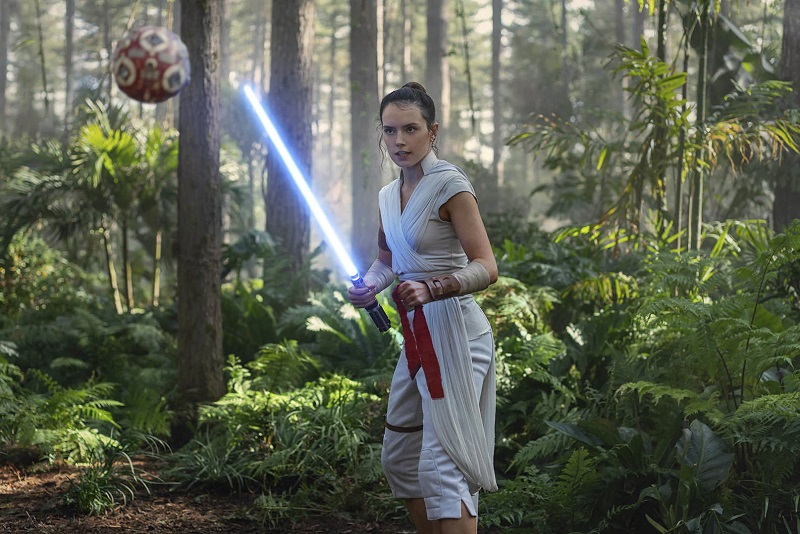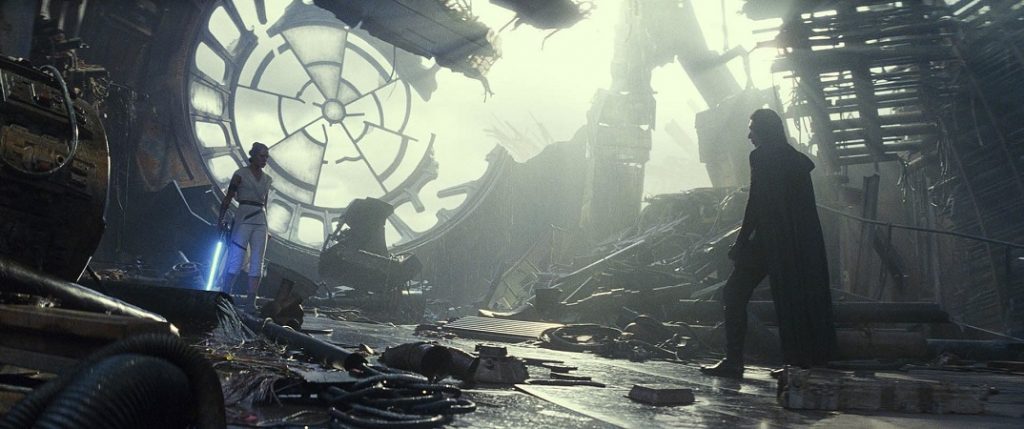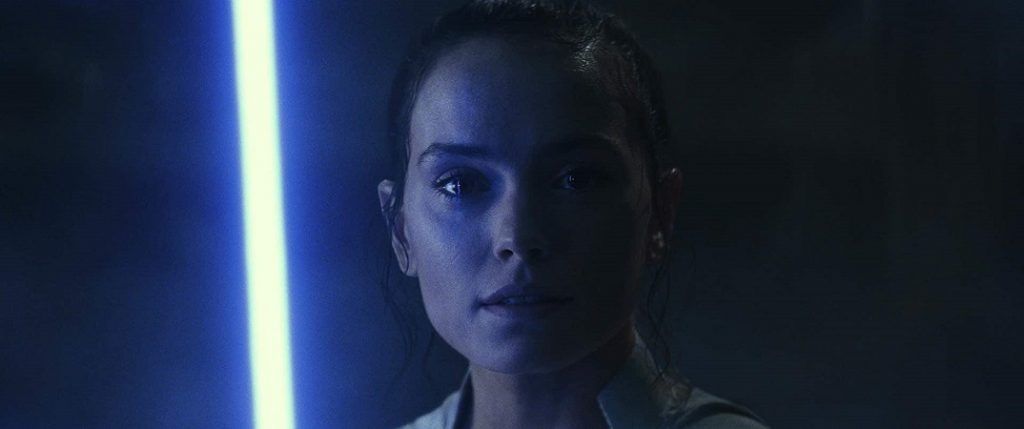Mastering Two Worlds: Concluding Rey’s Hero’s Journey in The Rise of Skywalker
We have previously analyzed in detail how The Force Awakensand The Last Jedi rely upon the Hero’s Journey framework in crafting their stories for Rey. Both Joseph Campbell’s monomyth, derived from historical legends around the globe, and Christopher Vogler’s model, reframed for the two-hour Hollywood blockbuster, serve as guideposts to the shape of Rey’s narrative in the first two movies. With The Rise of Skywalker, the Sequel Trilogy brings the heroic cycle of Rey’s character arc to a close.
In terms of its overall plot structure, The Rise of Skywalker more closely resembles Vogler’s model. The adventure is kick-started by word of the Emperor’s return and his Exegol fleet, compelling Rey to join her friends on a quest to find that location and a means to defeat him. Along the way they encounter a variety of enemies and allies during a series of tests. Those trials culminate in not one but two major showdowns for Rey: first with Kylo Ren at Kef Bir, then with Palpatine at Exegol. After the climax of her victory and her (seemingly literal) resurrection, Rey celebrates her triumph with her Resistance friends and then her Jedi mentors.
For her character arc in the movie, though, Rey’s journey is built on Campbell. Like Luke Skywalker in the Original Trilogy, Rey’s three-movie story in the Sequel Trilogy follows the three overall phases of Campbell’s monomyth: Departure from the ordinary world, Initiation in the extraordinary world, and Return to the ordinary world by synthesizing the lessons of both. In The Rise of Skywalker, Rey finishes her Campbellian heroic cycle – still the same optimistic scavenger we first met on Jakku, but also forever changed by her journey.

The third phase begins similar to the first. Accustomed to life in their ordinary world, the hero at first expresses a Refusal of the Call to adventure. So too, after their life-changing experiences in the extraordinary world, the hero initially struggles with a Refusal of the Return to the ordinary world. The Rise of Skywalker begins with Rey set apart from the rest of the Resistance on Ajan Kloss. She reads the Jedi texts alone in her quarters. She runs a training course in the jungle with remotes, not other people. She has Leia as her Jedi Master, but despite her meditations she struggles to commune with the Force and the spirits of the Jedi who came before her. When the Millennium Falcon returns to base with grim news from a First Order mole, Poe insists that they need Rey out with them in the fight, not holed up like a monk; Finn, her closer friend, agrees with the pilot. Rey remains hesitant, but not for long – hearing the planet name Exegol at the debriefing sparks her memory of the Jedi texts, including Luke’s own previous investigations, and she realizes that her active participation is necessary for the Resistance to prevail. Though Rey herself has told Leia that she does not feel her training is complete, Rey nevertheless knows time has run out. Rey, not anyone else, can finish what Luke started and locate the wayfinder to Exegol. And only a Jedi can defeat the reborn Emperor.
The hero often experiences a Magic Flight on the way back to the ordinary world. Rey does this multiple times in The Rise of Skywalker, naturally with the Force as her magic. On Pasaana, she vaults backward over Kylo Ren’s onrushing TIE fighter, slicing off its wing with her lightsaber. Over Kijimi, she leaps headlong from the open docking bay of the Steadfast and onto the boarding ramp of the Falcon beyond. At Ahch-To, the spirit of Luke Skywalker retrieves his sunken X-wing from its watery grave, and Rey travels to Exegol as Red Five, a long-dead icon of the Rebellion now reborn, as well.
The hero’s synthesis begins in earnest with Crossing the Return Threshold, bringing the boon of the extraordinary world back to the ordinary one. Rey continues her Jedi quest, finding Ochi’s dagger on Pasaana, retrieving Threepio’s memory of its Sith text on Kijimi, unlocking its secret clue to the location of the wayfinder at Kef Bir. Now she must ascend through the torn and rusting wreckage of the second Death Star to reach the vault concealed in the Emperor’s throne room. To do this, she does not levitate with the Force or propel herself with supernatural jumps. Instead, she returns to who she was when her journey started: the scavenger girl from Jakku, climbing her way through long-destroyed Imperial military craft to find the scrap or part that might earn her next meal.

But becoming a Master of Two Worlds is never easy. Kylo Ren destroys the Emperor’s wayfinder. Leia dies to reach the light inside her son. And worst of all, having unleashed Force lightning at Pasaana and learned the terrible truth of her heritage at Kijimi, Rey does not trust herself to stand firm in the light. Returning to Ahch-To, she receives one more lesson from Luke. When he asks her to speak her greatest fear, she tells the truth: “Myself.” In this one word, The Rise of Skywalker encapsulates all that has come before, from Yoda in The Empire Strikes Back (“Only what you take with you.”) and The Phantom Menace (“Fear leads to anger, anger leads to hate, hate leads to suffering.”), to Anakin’s failures in Attack of the Clones and Revenge of the Sith, to Luke’s burst of fury after Vader threatens to turn Leia in Return of the Jedi. The dark side is a temptation, nothing more; it neither proposes a Faustian bargain nor imposes a coercive extortion, but simply makes available the means to carry out the rationalizations one creates for oneself. And that is how Luke helps Rey see the light. “Some things,” he tells her, “are stronger than blood.” Luke and Leia knew her connection to their greatest enemy, but trained her anyway because they saw the truth of her heart. It is Rey the scavenger as much as Rey the Jedi who can defeat Palpatine. Rey scavenges Vader’s wayfinder from the smoldering ruins of Kylo Ren’s TIE fighter, affixes it to Luke’s X-wing, and departs to fulfill her Jedi destiny.
The final stage of Campbell’s model is Freedom to Live, which refers not so much to the synthesis itself as to the peace of mind the synthesis gives to the hero – a freedom to live because the hero is unafraid of death. At Exegol, Rey is not afraid. She flies through the maelstrom alone. She enters the Sith compound alone. She faces her grandfather, amid the cheering throngs of his cultists, alone. Ben Solo arrives too, but he cannot turn the tide. Palpatine promptly drains the life force from both of them to reforge his own corporeal form; when Ben tries to stand, Palpatine unceremoniously flings him into a chasm, an act of revenge for Ben’s grandfather’s act three decades earlier. Weakened to near death, laying on the ground, watching the Resistance fleet decimated and incapacitated in the sky above, it would be easy for Rey to feel afraid. But she is not. She returns to her first goal in the film: to commune with the spirits of Jedi past. “Be with me,” she asks. This time, they answer: “Rise.” And she does.
Rey is not afraid. She is not afraid of her grandfather. She is not afraid of the dark. And she is not afraid to die – unlike Palpatine, who craves eternal life. That is why she wins.

Already drained of most of her essence, the effort to channel the light side of the Force with enough strength to overpower the darkness of Palpatine requires all the energy Rey has left. It is a sacrifice she is willing to make to stop him once and for all. But for the heroes of Star Wars, hope is never lost – and there is still hope for Rey. Ben Solo was mostly drained too – but not entirely. Like his grandfather, he knows that he must bear the consequences of his years of evil deeds preceding his return to the light. He knows that it would selfish for him to live on, when the true hero of the Jedi, the one who never wavered from the right path, can still be saved. Just as Anakin used his final act to save Luke, so too Ben Solo’s final act saves Rey.
Borrowing from Vogler, The Rise of Skywalker concludes with an Epilogue to give the audience closure on Rey’s trilogy journey, to show that the circle is now complete. Bringing Red Five back to the Resistance base, she reunites with BB-8, even checking his antennae just as she did when they first met in The Force Awakens. She is greeted by cheers and shoulder pats of congratulation, just like Luke in A New Hope after destroying the Death Star. She finds Finn and Poe in the crowd, pulling them into an embrace even tighter than the heroes of the Rebellion at the end of Return of the Jedi. Then she flies the Falcon to Tatooine for a memorial for her two Jedi mentors. Discovering the Lars homestead gradually being consumed by the dunes, uninhabited for decades, Rey nevertheless feels the familiarity of the place. She takes a piece of scrap and slides down the sand slope, a grin on her face – the scavenger girl from Jakku is now a powerful Jedi and a galactic hero, but she has not lost who she is. And, no matter her bloodline, she has found a family. Sharing a smile with the spirits of Luke and Leia, she takes the Skywalker name for her own. Some things are stronger than blood.
Related Links:
- Rey’s Heroic Journey in The Force Awakens
- Hyperspace Theories Special Edition: Rey and the Hero’s Journey in The Force Awakens
- The Last Jedi and the Hero’s Journey – Part One: Rey











Pingback:Rey Deserved Better: The Failures of The Rise of Skywalker, Part 1 – FANgirl Blog
Pingback:Fridging Leia Organa: The Failures of The Rise of Skywalker, Part 2 – FANgirl Blog
Pingback:Finn’s Unfulfilled Potential: The Failures of The Rise of Skywalker, Part 4 – FANgirl Blog